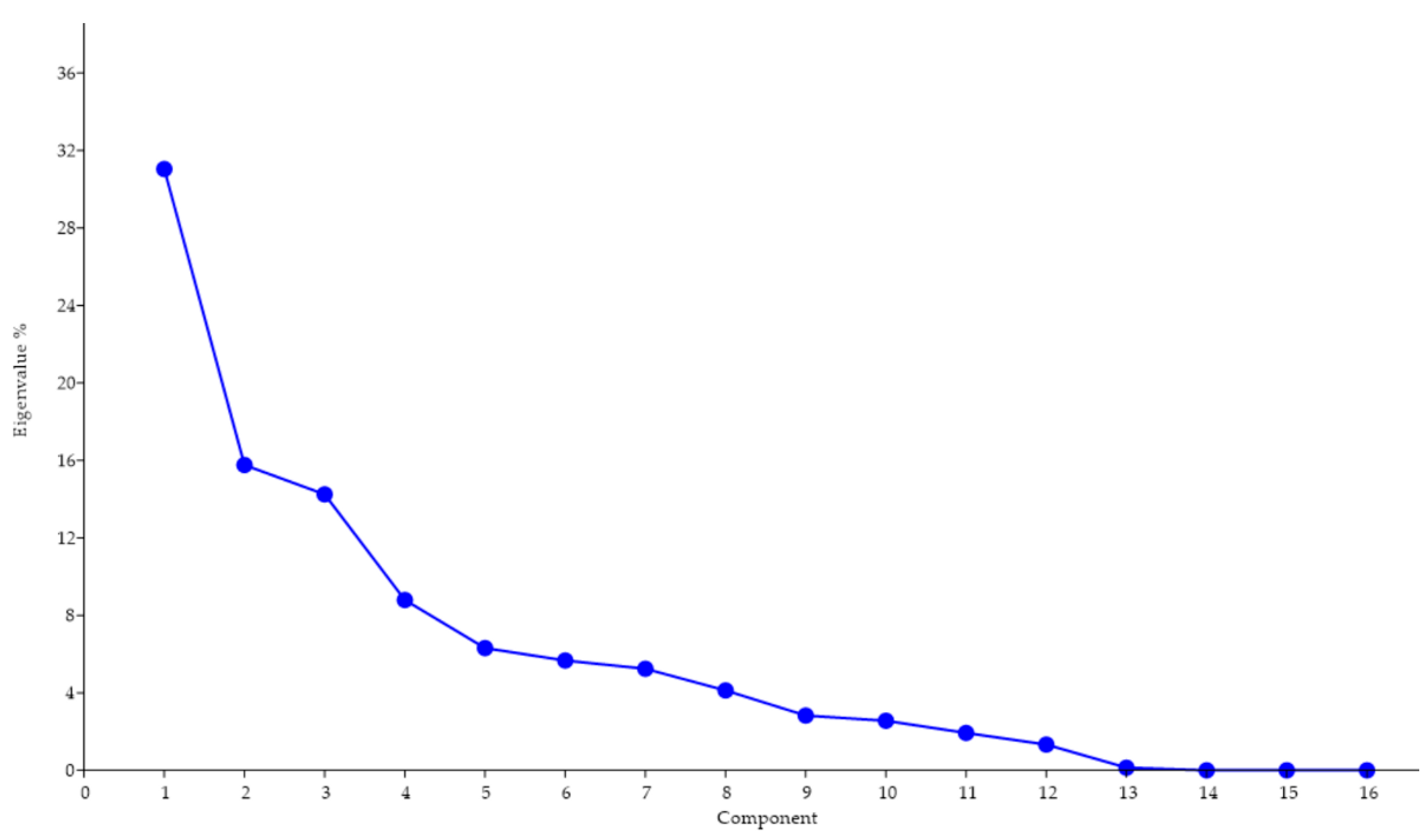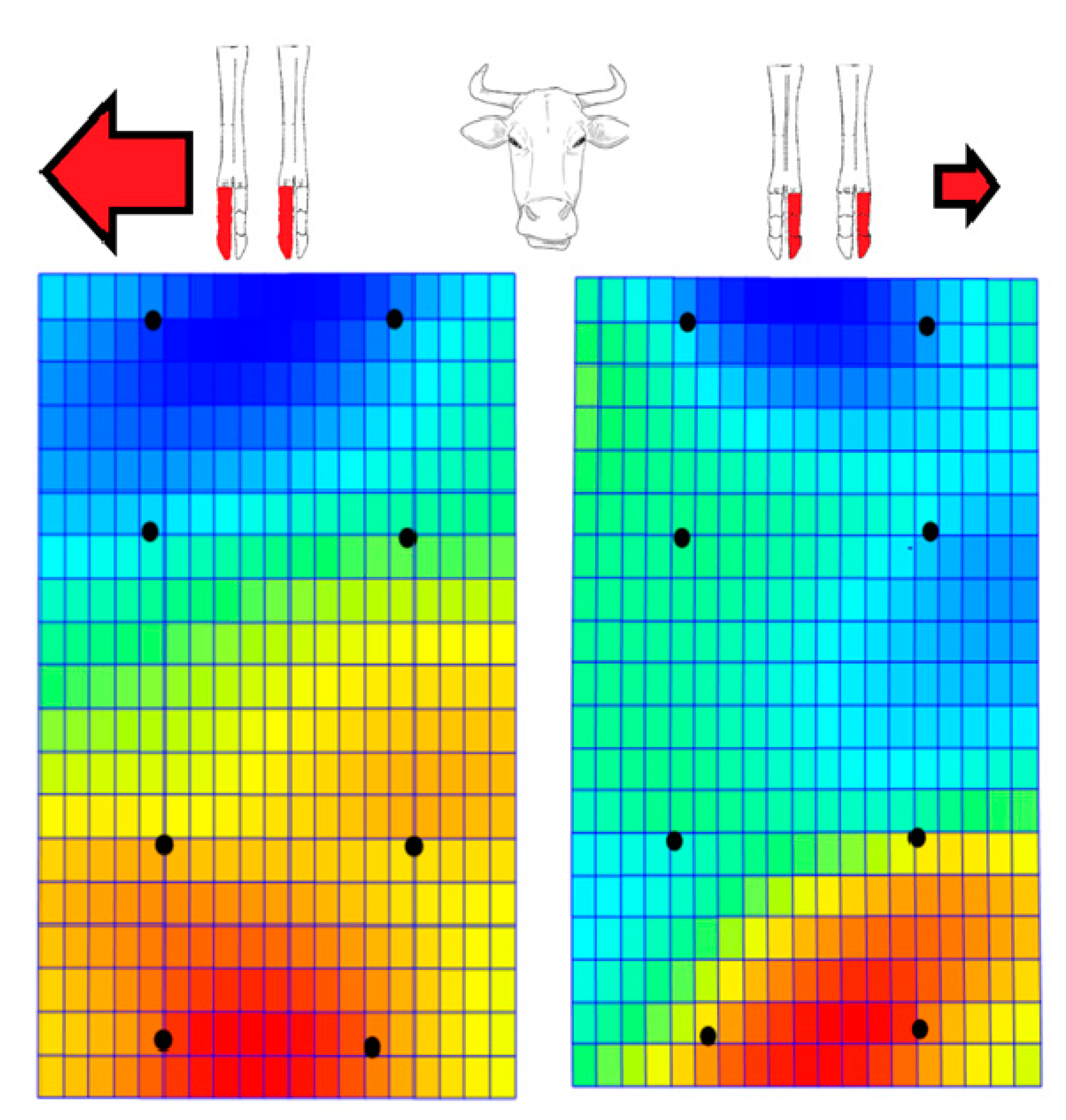Asymmetries of Forelimb Digits of Young Cattle
Abstract
:1. Introduction
2. Materials and Methods
Statistical Analyses
3. Results
3.1. Size Asymmetries
3.2. Allometry
3.3. Shape Asymmetries
4. Discussion
Author Contributions
Funding
Acknowledgments
Conflicts of Interest
References
- Sforza, C.; Michielon, G.; Fragnito, N.; Ferrario, V.F. Foot asymmetry in healthy adults: Elliptic fourier analysis of standardized footprints. J. Orthop. Res. 1998, 16, 758–765. [Google Scholar] [CrossRef]
- Mancini, S.; Sally, S.L.; Gurnsey, R. Detection of symmetry and anti-symmetry. Vis. Res. 2005, 45, 2145–2160. [Google Scholar] [CrossRef] [Green Version]
- Graham, J.H.; Freeman, D.C.; Emlen, J.M. Antisymmetry, directional asymmetry, and dynamic morphogenesis. Genetica 1993, 89, 121–137. [Google Scholar] [CrossRef]
- Auffray, J.C.; Debat, V.; Alibert, P. Shape asymmetry and developmental stability. In On Growth and Form: Spatio-Temporal Pattern Formation in Biology; Mark, J.C.M., Chaplain, A.J., Singh, G.D., Eds.; John Wiley and Sons Ltd.: New York, NY, USA, 1999; pp. 309–324. [Google Scholar]
- Costa, M.; Mateus, R.P.; Moura, M.O. Constant fluctuating asymmetry but not directional asymmetry along the geographic distribution of Drosophila antonietae (Diptera, Drosophilidae). Rev. Bras. Entomol. 2015, 59, 337–342. [Google Scholar] [CrossRef] [Green Version]
- Alados, C.L.; Navarro, T.; Escós, J.; Cabezudo, B.; Emlen, J.M. Translational and fluctuating asymmetry as tools to detect stress-adapted and nonadapted plants. Int. J. Plant Sci. 2001, 162, 607–616. [Google Scholar] [CrossRef] [Green Version]
- Angelopoulou, M.V.; Vlachou, V.; Halazonetis, D.J. Fluctuating molar asymmetry in relation to environmental radioactivity. Arch. Oral Biol. 2009, 54, 666–670. [Google Scholar] [CrossRef] [PubMed]
- Blackburn, A. Bilateral asymmetry of the humerus during growth and development. Am. J. Phys. Anthropol. 2011, 145, 639–646. [Google Scholar] [CrossRef] [PubMed]
- Niemeier, S.; Müller, J.; Rödel, M.O. Fluctuating asymmetry—Appearances are deceptive. Comparison of methods for assessing developmental instability in european common frogs (Rana temporaria). Salamandra 2019, 55, 14–26. [Google Scholar]
- Alibert, P.; Renaud, S.; Dod, B.; Bonhomme, F.; Auffray, J.C. Fluctuating asymmetry in the Mus musculus hybrid zone: A heterotic effect in disrupted co-adapted genomes. Proc. R. Soc. B Biol. Sci. 1994, 258, 53–59. [Google Scholar] [CrossRef]
- Berns, C.M. The Evolution of Sexual Dimorphism: Understanding Mechanisms of Sexual Shape Differences. In Sexual Dimorphism; Moriyama, H., Ed.; IntechOpen: Croatia, Balkans, 2013; pp. 1–15. [Google Scholar]
- Ginot, S.; Agret, S.; Claude, J. Bite Force Performance, Fluctuating Asymmetry and Antisymmetry in the Mandible of Inbred and Outbred Wild-Derived Strains of Mice (Mus musculus domesticus). Evol. Biol. 2018, 45, 287–302. [Google Scholar] [CrossRef]
- Carter, A.J.R.; Osborne, E.; Houle, D. Heritability of Directional Asymmetry in Drosophila melanogaster. Int. J. Evol. Biol. 2009, 1–7. [Google Scholar] [CrossRef] [PubMed] [Green Version]
- Lens, L.; Van Dongen, S. Fluctuating and directional asymmetry in natural bird populations exposed to different levels of habitat disturbance, as revealed by mixture analysis. Ecol. Lett. 2000, 3, 516–522. [Google Scholar] [CrossRef]
- Spani, F.; Scalici, M.; Crandall, K.A.; Piras, P. Claw asymmetry in crabs: Approaching an old issue from a new point of view. Biol. J. Linn. Soc. 2020, 129, 162–176. [Google Scholar] [CrossRef]
- Sisson, S.; Grossman, G.D. Anatomía de los Animales Domésticos; Tomo 1. Barcelona: Catalonia, Spain, 1985. [Google Scholar]
- Barone, R. Anatomie Comparée des Mamifères Domestiques; Tome 1. Ostéologie: Paris, France, 1999. [Google Scholar]
- Beteg, F.; Muste, A.; Mates, N.; Oana, L.; Ober, C.; Donisa, A. Lameness, Hoof Care and Functional Trimming in Cows—An Actual Review. Bull. Univ. Agric. Sci. Vet. Med. Cluj-Napoca-Vet. Med. 2007, 64, 359–364. [Google Scholar] [CrossRef]
- Mills, L.L.; Leach, D.H. A revised/proposed nomenclature for the external anatomical features of the bovine foot. Can. Vet. J. 1988, 29, 444–447. [Google Scholar]
- Deeming, L.E.; Beausoleil, N.J.; Stafford, K.J.; Webster, J.R.; Staincliffe, M.; Zobel, G. The development of a hoof conformation assessment for use in dairy goats. Animals 2019, 9, 973. [Google Scholar] [CrossRef] [PubMed] [Green Version]
- Keller, A.; Clauss, M.; Muggli, E.; Nuss, K. Even-toed but uneven in length: The digits of artiodactyls. Zoology 2009, 112, 270–278. [Google Scholar] [CrossRef] [Green Version]
- Mugglia, E.; SauterLouis, C.; Braun, U.; Nuss, K. Length asymmetry of the bovine digits. Vet. J. 2011, 188, 295–300. [Google Scholar] [CrossRef] [Green Version]
- Cocilovo, J.A.; Varela, H.H.; Quevedo, S. La asimetría bilateral y la inestabilidad del desarrollo. Rev. Argent. Antropol. Biol. 2006, 8, 121–144. [Google Scholar]
- Kubicka, A.M.; Lubiatowski, P.; Długosz, J.D.; Romanowski, L.; Piontek, J. Directional asymmetry of upper limbs in a medieval population from Poland: A combination of linear and geometric morphometrics. Am. J. Hum. Biol. 2016, 28, 817–824. [Google Scholar] [CrossRef]
- Webster, M.; Sheets, H.D. A practical introduction to landmark-based geometric morphometrics. In Quantitative Methods in Paleobiology; Alroy, J., Hunt, G., Eds.; The Paleontological Society: Baltimore, MD, USA, 2010; pp. 163–188. [Google Scholar]
- Adams, D.C.; Rohlf, F.J.; Slice, D.E. A field comes of age: Geometric morphometrics in the 21st century. Hystrix 2013, 24, 7–14. [Google Scholar] [CrossRef]
- Klingenberg, C.P. Analyzing fluctuating asymmetry with geometric morphometrics: Concepts, methods and applications. Symmetry 2015, 7, 843–934. [Google Scholar] [CrossRef] [Green Version]
- Cerveny, C. Anatomical Characteristics on the Ossa Sesamoidea Phalangis Proximalis in Cattle (Bos primigenius F. taurus Linné 1758). Acta Vet. Brno 1985, 54, 3–22. [Google Scholar] [CrossRef] [Green Version]
- Phillips, C.J.C.; Dewi, C.; Whitaker, J.; Patterson, S.J. Volume assessment of the bovine hoof. Res. Vet. Sci. 1996, 61, 125–128. [Google Scholar] [CrossRef]
- Ocal, M.K.; Sevil, F.; Parin, U. A quantitative study on the digital bones of cattle. Ann. Anat. 2004, 186, 165–168. [Google Scholar] [CrossRef]
- Phillips, C.J.C.; Oevermans, H.; Syrett, K.L.; Jespersen, A.Y.; Pearce, G.P. Lateralization of behavior in dairy cows in response to conspecifics and novel persons. J. Dairy Sci. 2015, 98, 2389–2400. [Google Scholar] [CrossRef] [Green Version]
- Blowey, R.W. Lameness in the Foot. In Bovine Medicine. Diseases and Husbandry of Cattle, 2nd ed.; Andrews, A.H., Ed.; Blackwell Publishing Ltd.: Oxford, UK, 2004. [Google Scholar]
- van der Tol, P.P.J.; van der Beek, S.S.; Metz, J.H.M.; Noordhuizen-Stassen, E.N.; Back, W.; Braam, C.R.; Weijs, W.A. The effect of preventive trimming on weight bearing and force balance on the claws of dairy cattle. J. Dairy Sci. 2004, 87, 1732–1738. [Google Scholar] [CrossRef]
- Weiss, M.; Hainke, K.; Grund, S.; Gerlach, K.; Mülling, C.K.; Geiger, S.M. Does the range of motion in the bovine interphalangeal joints change with flooring condition? A pilot study using biplane high-speed fluoroscopic kinematography. J. Dairy Sci. 2019, 2, 1443–1456. [Google Scholar] [CrossRef] [Green Version]
- Parés-Casanova, P.M. Data of beef carcasses belonging to the “Vedella dels Pirineus Catalans” label produced in Cataluña (Spain). Redvet 2009, 10, 1–13. [Google Scholar]
- Hoey, S.E.; Biedrzycki, A.H.; Livesey, M.J.; Drees, R. Radiographic anatomy of juvenile bovine limbs. Vet. Rec. 2016, 179, 546. [Google Scholar] [CrossRef]
- Rohlf, F.J. The tps series of software. Hystrix 2015, 26, 9–12. [Google Scholar] [CrossRef]
- Rohlf, F.J. Digitalized landmarks and outlines. In Stony Brook: Department of Ecology and Evolution; State University of New York: New York, NY, USA, 2010. [Google Scholar]
- Bookstein, F.L. Morphometric Tools for Landmark Data: Geometry and Biology; Cambridge University Press: Cambridge, UK, 1991. [Google Scholar]
- Klingenberg, C.P. MorphoJ: An integrated software package for geometric morphometrics. Mol. Ecol. Resour. 2011, 11, 353–357. [Google Scholar] [CrossRef]
- Hammer, Ø.; Harper, D.A.T.; Ryan, P.D. PAST v. 2.17c. Palaeontol. Electron. 2001, 4, 1–229. [Google Scholar]
- Nocek, J.E. Bovine Foot Anatomy: A Functional and Practical Perspective. Prof. Anim. Sci. 1986, 2, 1–4. [Google Scholar] [CrossRef]
- Klingenberg, C.P.; McIntyre, G.S. Geometric morphometrics of developmental instability: Analyzing patterns of fluctuating asymmetry with procrustes methods. Evolution 1998, 52, 1363. [Google Scholar] [CrossRef] [PubMed]
- Mülling, C.K.W.; Greenough, P.R. Functional synergism of the biomechanical systems of the bovine claw. In Proceedings of the 15th International Symposium & Conference on Lameness in Ruminants, Kuopio, Finland, 9–13 June 2008; pp. 7–9. [Google Scholar]
- Gitau, T.; Mbiuki, S.M.; McDermott, J.J. Assessment of bovine hoof conformation and its association with lameness, animal factors and management practices on small-scale dairy farms in Kiambu district, Kenya. Onderstepoort J. Vet. Res. 1997, 64, 135–140. [Google Scholar] [PubMed]
- Laven, L.J.; Wang, L.; Regnerus, C.; Laven, R.A. Measuring claw conformation in cattle: Assessing the agreement between manual and digital measurement. Animals 2015, 5, 687–701. [Google Scholar] [CrossRef] [PubMed]





| Source | Sum of Squares | Df | Mean Squares | F | p |
|---|---|---|---|---|---|
| Right forelimb (n = 17) | |||||
| Individual | 0.032029 | 16 | 0.0020018 | 32.306 | 0.0001 |
| Side | 0.027964 | 1 | 0.0279640 | 45.128 | 0.0001 |
| Interaction | 0.018533 | 16 | 0.0011583 | 18.693 | 0.0002 |
| Residual | 0.021068 | 34 | 0.0006196 | ||
| Total | 0.099594 | 67 | |||
| Left forelimb (n = 17) | |||||
| Individual | 0.033277 | 16 | 0.0020798 | 40.677 | 0.0001 |
| Side | 0.028572 | 1 | 0.0285720 | 55.881 | 0.0001 |
| Interaction | 0.019052 | 16 | 0.0011908 | 23.289 | 0.0001 |
| Residual | 0.017384 | 34 | 0.0005113 | ||
| Total | 0.098285 | 67 | |||
© 2020 by the authors. Licensee MDPI, Basel, Switzerland. This article is an open access article distributed under the terms and conditions of the Creative Commons Attribution (CC BY) license (http://creativecommons.org/licenses/by/4.0/).
Share and Cite
Parés-Casanova, P.M.; Castel-Mas, L.; Jones-Capdevila, K.N. Asymmetries of Forelimb Digits of Young Cattle. Vet. Sci. 2020, 7, 83. https://doi.org/10.3390/vetsci7030083
Parés-Casanova PM, Castel-Mas L, Jones-Capdevila KN. Asymmetries of Forelimb Digits of Young Cattle. Veterinary Sciences. 2020; 7(3):83. https://doi.org/10.3390/vetsci7030083
Chicago/Turabian StyleParés-Casanova, Pere M., Laura Castel-Mas, and Kirian N. Jones-Capdevila. 2020. "Asymmetries of Forelimb Digits of Young Cattle" Veterinary Sciences 7, no. 3: 83. https://doi.org/10.3390/vetsci7030083






